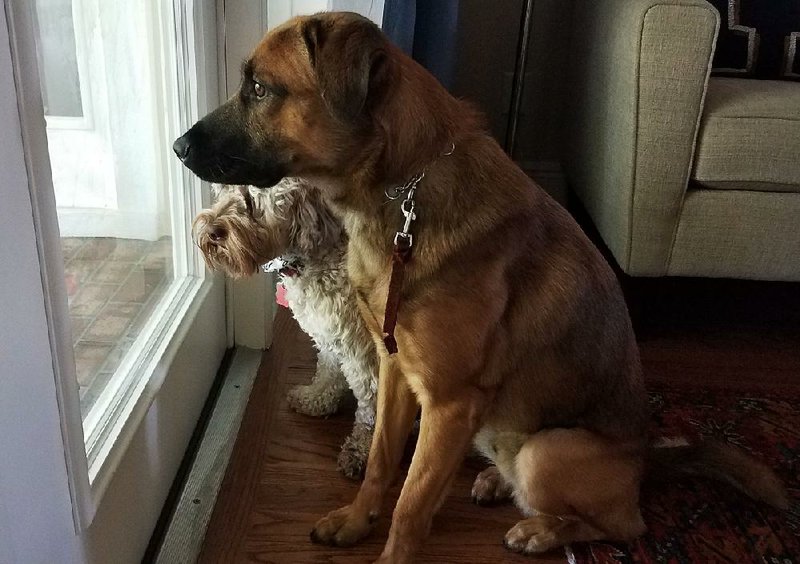My husband, DC, and I are in the doghouse. That is, our house is under canine government now that the dogs outnumber us three to two. The newest member, recently rescued from one of our kids, is a 14-month-old, exuberant hound mix. Luke, whom we renamed after a saint whose help we hope to invoke, moved in two weeks ago after 18-days of doggie boot camp.
The fur has been flying since.
For context, I need to tell you that I had another plan. I always imagined that I would grow up someday into one of those put-together, smartly dressed ladies, who would walk her nicely groomed, well-mannered pooch -- a regal Cavalier King Charles, perhaps, or maybe a matched set of pristine Westies -- through manicured neighborhoods. As I walked my well-dressed self by the neighbors, I would leave behind just the faintest scent of fine fragrance, something with a bergamot base.
In fact, I'm a just-out-of-bed, hair-a-mess dame in yoga pants with three mixed-breed dogs pulling me down the street like a sled team, dislocating my shoulder at every squirrel sighting. Whatever waft I leave in my wake comes from the ever-present plastic poop sacks that bop along with our motley crew.
I must, however, look somewhat professional since people looking to hire a dogwalker have asked for my card.
(I will pause here to say that I would completely understand if you never took my advice about anything again. Why would you?)
My reputation and appearance are not all that have gone to the dogs. My house has, too. Paw and nose prints cover the lower half of the glass doors like finger paintings. Every day, I sweep up a mound of fur the size of a small rabbit. DC and I are running defense, trying to get ahead of a Marmaduke-like dog who uses the new white sectional as part of his lap track, excels at counter surfing, and gets on our bed when we're not home. (At least he doesn't crawl in beside me when I'm asleep and pretend he's DC anymore. I put a fast stop to that.)
All because a month ago, four fateful words -- "We'll take the dog" -- leapt from my well-intentioned heart past the guard gate of my lips.
"What exactly do you want us to work on?" asked the trainer, Rock Galloway, owner of Central Florida K9, when we brought an anxious Luke in for evaluation.
I gave Galloway my wish list as if ordering from a menu, (if it were only that simple): "I want a dog that is potty trained, friendly, not destructive, obeys basic commands, can tell the difference between his toys and my shoes, stays off furniture, walks nicely on a leash, and won't put his nose in inappropriate places when my I host the ladies in my book club."
"So basic manners and obedience," Galloway said, unfazed.
"Look," I continued, "I don't need this dog to detect drugs in a duffle, track a runaway convict, or prevent anyone from falling into a diabetic coma," (all tasks Galloway trains dogs to do). "I just don't want a hand grenade in my pretty house."
"Can do, but we'll need to train you, too."
And off we went.
The new, improved, but still-learning Luke and I both have more to learn, but on this Luke would bet his bottom milk bone and I my last piece of chocolate: If you want to live beautifully with a dog, especially a larger one, obedience training is essential. Here's what Galloway says dogs need to become fit to live with:
Basic training. Dogs love to learn. A professional trainer can lay the foundation for good dog behavior through conditioning, but that will only stick if owners follow through. As Galloway told us, "Luke now has a baseline, but I want to make sure you guys understand it's not over. He's a work in progress." Although young dogs are more trainable, a dog's age isn't as big a problem as people think.
Consistency. "The biggest mistake dog owners make is not being consistent," Galloway said. After boot-camp, dogs will test the boundaries at home. (Luke, off!) If you don't reinforce that training, you can undo it.
A bond. Build a good relationship with your dog by hanging out with him. Feed and play with him, and do what he enjoys. How a dog learns rests upon that rapport.
Socializing. Not getting a young dog out among people and dogs ranks high on the list of mistakes owners make. Unsocialized dogs cause the biggest problems. "One year down the road, you're going to be spending a lot of money getting that dog fixed," Galloway said. "Dogs are pack animals. They need to learn how to deal with each other."
Hand holding. When bringing a new dog home, show him around. If he's anxious, your being there can help him push through the uncertainty, the noises, smells and scary hallways.
Exercise. Dogs become destructive when they need more exercise, said Galloway, who recommends at least an hour of exercise a day for active dogs. "People get these large working dogs and don't have the time to train or exercise them. Then the dog gets destructive, because he needs an outlet for his energy."
Routine. Like kids, dogs do better with a schedule. They like structure. "When we talk about training," he said, "structure, socialization and bonding are the three pillars."
Time. Maturity matters. "Behavior gets better when dogs get to age 3 or 4 and are out of their teenage phase," Galloway said. Toy breeds get there even sooner. "By then, the kinks smooth out."
Syndicated columnist Marni Jameson is the author of five home and lifestyle books, including Downsizing the Family Home -- What to Save, What to Let Go.
HomeStyle on 06/08/2019

